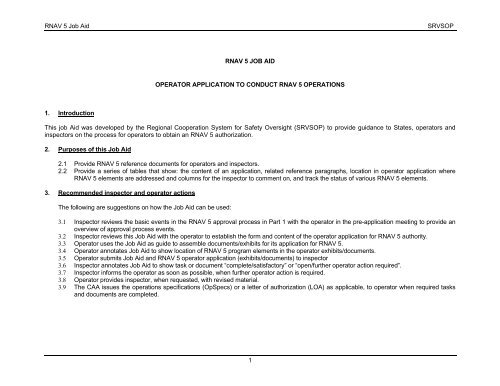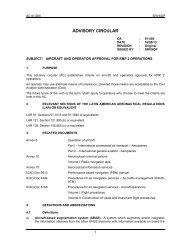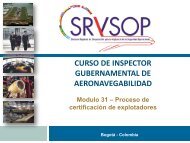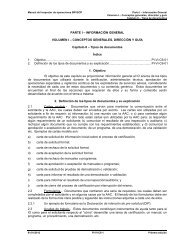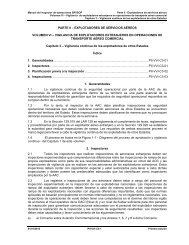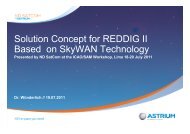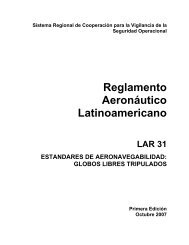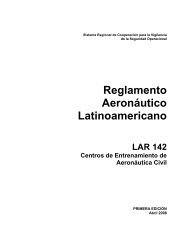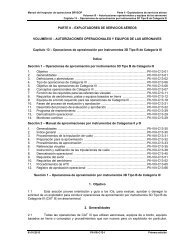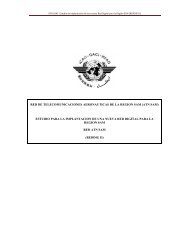RNAV 5 Job Aid SRVSOP 1 RNAV 5 JOB AID OPERATOR ... - ICAO
RNAV 5 Job Aid SRVSOP 1 RNAV 5 JOB AID OPERATOR ... - ICAO
RNAV 5 Job Aid SRVSOP 1 RNAV 5 JOB AID OPERATOR ... - ICAO
Create successful ePaper yourself
Turn your PDF publications into a flip-book with our unique Google optimized e-Paper software.
<strong>RNAV</strong> 5 <strong>Job</strong> <strong>Aid</strong> <strong>SRVSOP</strong><strong>RNAV</strong> 5 <strong>JOB</strong> <strong>AID</strong><strong>OPERATOR</strong> APPLICATION TO CONDUCT <strong>RNAV</strong> 5 OPERATIONS1. IntroductionThis job <strong>Aid</strong> was developed by the Regional Cooperation System for Safety Oversight (<strong>SRVSOP</strong>) to provide guidance to States, operators andinspectors on the process for operators to obtain an <strong>RNAV</strong> 5 authorization.2. Purposes of this <strong>Job</strong> <strong>Aid</strong>2.1 Provide <strong>RNAV</strong> 5 reference documents for operators and inspectors.2.2 Provide a series of tables that show: the content of an application, related reference paragraphs, location in operator application where<strong>RNAV</strong> 5 elements are addressed and columns for the inspector to comment on, and track the status of various <strong>RNAV</strong> 5 elements.3. Recommended inspector and operator actionsThe following are suggestions on how the <strong>Job</strong> <strong>Aid</strong> can be used:3.1 Inspector reviews the basic events in the <strong>RNAV</strong> 5 approval process in Part 1 with the operator in the pre-application meeting to provide anoverview of approval process events.3.2 Inspector reviews this <strong>Job</strong> <strong>Aid</strong> with the operator to establish the form and content of the operator application for <strong>RNAV</strong> 5 authority.3.3 Operator uses the <strong>Job</strong> <strong>Aid</strong> as guide to assemble documents/exhibits for its application for <strong>RNAV</strong> 5.3.4 Operator annotates <strong>Job</strong> <strong>Aid</strong> to show location of <strong>RNAV</strong> 5 program elements in the operator exhibits/documents.3.5 Operator submits <strong>Job</strong> <strong>Aid</strong> and <strong>RNAV</strong> 5 operator application (exhibits/documents) to inspector3.6 Inspector annotates <strong>Job</strong> <strong>Aid</strong> to show task or document “complete/satisfactory” or “open/further operator action required”.3.7 Inspector informs the operator as soon as possible, when further operator action is required.3.8 Operator provides inspector, when requested, with revised material.3.9 The CAA issues the operations specifications (OpSpecs) or a letter of authorization (LOA) as applicable, to operator when required tasksand documents are completed.1
<strong>SRVSOP</strong> <strong>RNAV</strong> 5 <strong>Job</strong> <strong>Aid</strong>4. <strong>Job</strong> <strong>Aid</strong> organizationParts Subjects PagePart 1 General information 4Part 2 Operator and aircraft identification information 6Part 3 Operator application for <strong>RNAV</strong> 5 authority (Exhibits and documents) 7Part 4 Content of operator application for <strong>RNAV</strong> 5 authorization 10Part 5 Guide for determining <strong>RNAV</strong> 5 aircraft eligibility 13Part 6 Basic flight crew procedures for <strong>RNAV</strong> 5 operations 165. Primary source of documents, information and contactsFor accessing to the Advisory Circular CA 91-002, enter to the <strong>ICAO</strong>/SAM Regional Office Webpage (www.lima.icao.int) under <strong>SRVSOP</strong>.6. Primary documents of referenceDocuments of reference<strong>ICAO</strong> Doc 9613AMC 25-11AMC 20-5AC 20-121AAC 20-130()AC 20-138AAC 25-4AC 25-15AC 90-45AETSO-C115bETSO-C129AETSO-C145ETSO-C146TSO-C115, any versionSubjectsPerformance based navigation manualElectronic display systemAcceptable means of compliance for airworthiness approval and operational criteria for the use of theNAVSTAR Global positioning system (GPS)Airworthiness approval of LORAN C for use en the U.S National Airspace SystemAirworthiness approval of multi-sensor navigational system for use in the U.S. National Airspace SystemAirworthiness approval of Global navigation satellite system (GNSS) equipmentInertial navigation system (INS)Approval of FMS in transport category airplanesApproval of areas navigation systems for use in the U.S. National Airspace SystemAirborne area navigation equipment using multi sensor inputAirborne supplemental navigation equipment using the Global positioning system (GPS)Airborne navigation sensors using the Global positioning system (GPS) augmented by wide areaaugmentation system (WAAS)Stand-alone airborne navigation equipment using the Global positioning system (GPS) augmented by thewide area augmentation system (WAAS)Airborne area navigation equipment using multi-sensor inputs2
<strong>SRVSOP</strong> <strong>RNAV</strong> 5 <strong>Job</strong> <strong>Aid</strong>PAGE LEFT BLANK INTENTIONALLY4
<strong>RNAV</strong> 5 <strong>Job</strong> <strong>Aid</strong> <strong>SRVSOP</strong>PART 1: GENERAL INFORMATIONBasic events in <strong>RNAV</strong> 5 approval processOperator actionsCAA actions (inspectors)1 Establishes the need to obtain the <strong>RNAV</strong> 5 authorization.2 Reviews AFM, AFM Supplement or Type Certificate Data Sheet (TCDS) orothers appropriate documents (e.g., Service Bulletins, Service Letters) todetermine Aircraft eligibility for <strong>RNAV</strong> 5. Operator contacts airplane oravionics manufacturer, if necessary, to confirm airplane eligibility for <strong>RNAV</strong> 5.3 Contacts to the AAC to arrange a pre-application meeting to discussrequirements for operational approval. .4 During pre-application meeting, establishes:• form and content of operator application;• the date when operator application should be submittedfor evaluation5 Submits operator application to the AAC at least 60 days in advance of theplanned start of <strong>RNAV</strong> 5 operations.6 Reviews operator application7 Once the amendments to the manuals, programs and documents have beenaccepted or approved, the operator provides training to the flight crew, flightdispatchers and maintenance personnel and performs a validation flight incase of that flight is required by the AAC.8 Issues operational approval in the form of OpSpecs for LAR121 and/or 135 or a letter of authorization (LOA) for LAR 91operators.5
<strong>SRVSOP</strong> <strong>RNAV</strong> 5 <strong>Job</strong> <strong>Aid</strong>Notes related with the approval process1. Responsible Authority.a. Commercial Air Transport - LAR 121 and/or 135 or equivalent regulations operators.- The State of registry makes the determinationthat the Aircraft meets the applicable <strong>RNAV</strong> 5 requirements. The State of operator issues operating authority (e.g., OpSpecs).b. General aviation - LAR 91 or equivalent regulations operators.- The State of registry makes determination that aircraft meets theapplicable <strong>RNAV</strong> 5 requirements and issues a LOA.2. Sections related to the Latin American Aeronautical Regulations (LAR) or equivalents.a. LAR 91 Section 91.1015 and 91.1640 or equivalentsb. LAR 121 Section 121.995 (b) or equivalentc. LAR 135 Section 135.565 (c) or equivalent3. Others related <strong>ICAO</strong> documentsa. Annex 2 – Rules of the airb. Doc 4444 – Procedures for Air Navigation Services – Air Traffic Management.6
<strong>RNAV</strong> 5 <strong>Job</strong> <strong>Aid</strong> <strong>SRVSOP</strong>PART 2: AIRCFRAT AND <strong>OPERATOR</strong>S IDENTIFICATION INFORMATION<strong>OPERATOR</strong> NAME: ___________________________________________Aircraft make, modeland seriesRegistrationnumber(s)Serial number(s)<strong>RNAV</strong> navigation systems:Number, manufacturer and modelNavigation specificationrequestedDATE OF PRE-APPLICATION MEEETING__________________________________________________DATE APPLICATION RECEIVED:_________________________________________________________DATE <strong>OPERATOR</strong> PLANS TO START <strong>RNAV</strong> 5 OPERATIONS__________________________________¿IS THE NOTIFICATION TIME TO CAA ADEQUATE? YES _____ NO _____7
<strong>SRVSOP</strong> <strong>RNAV</strong> 5 <strong>Job</strong> <strong>Aid</strong>PAGE LEFT BLANK INTENTIONALLY8
<strong>RNAV</strong> 5 <strong>Job</strong> <strong>Aid</strong> <strong>SRVSOP</strong>PART 3 – <strong>OPERATOR</strong> APLICATION (EXHIBITS/DOCUMENTS)ExhibitDocument titleOperatorindication ofinclusionInspector commentsAOperator letter requesting <strong>RNAV</strong> 5 authorizationB 1. For aircraft manufactured <strong>RNAV</strong> 5 compliant:Airworthiness documents that show <strong>RNAV</strong> 5 approval:• AFM, AFM Supplement, TCDS o POH.2. For in-service aircraft which eligibility can not bedetermined based on the AFM, AFM Supplement; TCDS oPOH:• Operator letter requesting assessment of aircraft <strong>RNAV</strong>equipment.CDEFor INS or IRU only equipped aircraft: <strong>RNAV</strong> 5 time limit andarea of operation.• Documentation establishing the <strong>RNAV</strong> 5 time limit and area ofoperations or routes for which the specific aircraft/navigationsystem is eligible. (Not applicable to GPS equipped aircraft).Maintenance program• For aircraft with established <strong>RNAV</strong> 5 or GPS stand-alonemaintenance practices, provide list of document or programreferences.Minimum Equipment List (MEL) (Only for operators operatingunder an MEL):• MEL showing provisions for <strong>RNAV</strong> 5 equipment or GPS standalone.F Training9
<strong>SRVSOP</strong> <strong>RNAV</strong> 5 <strong>Job</strong> <strong>Aid</strong>ExhibitDocument title1. LAR 91 operators: Methods of training: The followingmethods are acceptable for these operators: In-house training,LAR 142 training center or others courses of training.2. LAR 121 or 135 operators: Training program: The LAR 121or 135 operators shall provide initial and recurrent trainingprogram for flight crew, flight dispatchers and maintenancepersonnel.3. GPS stand-alone: When the operator used a GPS stand-aloneto conduct <strong>RNAV</strong> 5 operations, shall provide an initial and arecurrent training program for flight crew, flight dispatchers andmaintenance personnel, if required.Operatorindication ofinclusionInspector commentsGOperational policies and procedures1. LAR 91 operators: Operations manual or sections of operator’sapplication, documenting <strong>RNAV</strong> 5 operational policies andprocedures.2. LAR 121 and/or 135 operators: Operations manual and checklist.3. GPS stand-alone used as a primary means of navigation:Operations manualH Removal of <strong>RNAV</strong> 5 operating authorityIndication of the necessity to follow up action after navigation errorreports, and the potential for removal of <strong>RNAV</strong> 5 operating authority.IPlan for validation flight: Only if required by the CAA10
<strong>RNAV</strong> 5 <strong>Job</strong> <strong>Aid</strong> <strong>SRVSOP</strong>APLICATION CONTENT TO BE SUBMITED BY THE <strong>OPERATOR</strong>____________AIRCRAFT/<strong>RNAV</strong> 5 SYSTEM COMPLIANCE DOCUMENTATIONOPERATIONAL POLICY/PROCEDURESMAINTENANCE MANUAL SECTIONS RELATED TO <strong>RNAV</strong> 5 SYSTEM OR GPS STAND-ALONE (if not previously reviewed)Note 1: Exhibits/documents may be included in a binder or submitted as a stand-alone documents11
<strong>SRVSOP</strong> <strong>RNAV</strong> 5 <strong>Job</strong> <strong>Aid</strong>PAGE LEFT BLANK INTENTIONALLY12
<strong>RNAV</strong> 5 <strong>Job</strong> <strong>Aid</strong> <strong>SRVSOP</strong>PART 4: CONTENT OF <strong>OPERATOR</strong> APPLICATION FOR <strong>RNAV</strong> 5#Content of operator application for<strong>RNAV</strong> 5Reference paragraphsCA 91-002Where found in operatorexhibit/documentsInspectorrecommendationand /or commentsInspectorTracking: Itemstatus and date1 Operator request letterStatement of intent to obtain <strong>RNAV</strong> 5authorization2 Airworthiness documents todetermine Aircraft eligibilityAirworthiness documents thatestablish the aircraft and thenavigation system have beenapproved for <strong>RNAV</strong> 5 operations.3 <strong>RNAV</strong> 5 system requirementsDocuments that show the aircraftequipment.1. One (1) navigation systemcomprising of:• one or a combination of thefollowing navigation sensors:VOR/DME, DME/DME, INS oIRS y GNSS;• an <strong>RNAV</strong> computer;• a control display unit (CDU);and• a navigation display(s) orinstrument(s) (e. g.,navigation display (ND),Paragraph 9.1 b) 1)Appendix 3, Paragraphe)Paragraphs: 8.2 y 8.3Paragraph 8.5 b)Exhibit AExhibit BExhibit CExhibit BExhibit C13
<strong>SRVSOP</strong> <strong>RNAV</strong> 5 <strong>Job</strong> <strong>Aid</strong>#Content of operator application for<strong>RNAV</strong> 5Reference paragraphsCA 91-002Where found in operatorexhibit/documentsInspectorrecommendationand /or commentsInspectorTracking: Itemstatus and dateheading situation indicator(HSI) o course deviationindicator (CDI).4 Availability of the conventionalnavigation equipment on board theaircraft when the GPS stand-aloneis usedDocuments that show the availabilityof the conventional navigationequipment on board the aircraft whenthe GPS stand-alone is used.When GPS stand-alone equipment isused, the traditional navigationequipment (e. g., VOR, DME, TACANo ADF), must be installed andoperational in the aircraft, so as toprovide an alternative means ofnavigation.5 Training1. LAR 91 operators: Methods oftraining: The following methodsare acceptable for theseoperators: In-house training, LAR142 training center or otherscourses of training.2. LAR 121 or 135 operators:Training program: The LAR 121or 135 operators shall develop aninitial and recurrent trainingParagraphs: 8.4 d) 1) (d)and 10.4 b) 2).Paragraphs: 8.7 e); 9.1b) 6) and 12Exhibit BExhibit CExhibit F14
<strong>RNAV</strong> 5 <strong>Job</strong> <strong>Aid</strong> <strong>SRVSOP</strong>#Content of operator application for<strong>RNAV</strong> 5Reference paragraphsCA 91-002Where found in operatorexhibit/documentsInspectorrecommendationand /or commentsInspectorTracking: Itemstatus and dateprogram for flight crew, flightdispatchers and maintenancepersonnel.3. GPS stand-alone: When theoperator uses a GPS stand-aloneto conduct <strong>RNAV</strong> 5 operations,shall developed an initial and arecurrent training program forflight crew, flight dispatchers andmaintenance personnel, ifrequired.Paragraph 8.4 d) 2)6 Operational policies andprocedures1. LAR 91 operators: Operationsmanual or sections of operator´sapplication, documenting <strong>RNAV</strong> 5operational policies andprocedures.2. LAR 121 and/or 135 operators:Operations manual and check list.3. GPS stand-alone used as aprimary means of navigation:Operations manual7 Maintenance practices• For Aircraft with established<strong>RNAV</strong> or GPS stand-alonemaintenance practices, theoperator shall provide documentParagraph 9.1 b) 2)Paragraph 10Paragraph 10. b)Paragraphs: 8.7 d) and9. b) 3)Exhibit GExhibit D15
<strong>SRVSOP</strong> <strong>RNAV</strong> 5 <strong>Job</strong> <strong>Aid</strong>#Content of operator application for<strong>RNAV</strong> 5Reference paragraphsCA 91-002Where found in operatorexhibit/documentsInspectorrecommendationand /or commentsInspectorTracking: Itemstatus and datereferences.• For newly installed <strong>RNAV</strong> or GPSstand-alone, the operator shallprovide maintenance practices forreview.8 Minimum equipment list (MEL)updates, if applicableOnly applicable if operator conductsoperations under an MELParagraph 9. b) 5)Exhibit E9 Continued airworthiness Paragraph 8.7 Exhibit H10 Removal of <strong>RNAV</strong> 5 operatingauthorityIndication of the necessity to follow upaction after navigation error reports,and the potential for removal of <strong>RNAV</strong>5 operating authority.Paragraph 11Exhibit H16
<strong>RNAV</strong> 5 <strong>Job</strong> <strong>Aid</strong> <strong>SRVSOP</strong>PART 5 – GUÍDE FOR DETERMINING AIRCRAFT ELIGIBILTY# Subjects ReferenceparagraphsCA 91-002Location inoperatorexhibitsCAARecommendations andcommentsInspector trackingitem status and date1 <strong>RNAV</strong> system requirement Paragraphs: 6.1 c) y8.5 b).Exhibit B2 Aircraft eligibility1. For aircraft manufactured <strong>RNAV</strong> 5compliant2. For in-service aircraft which eligibilitycan not be determined based on theAFM, AFM Supplement; TCDS oPOH:Paragraph 8.2Paragraph 8.3Exhibit B3 Limitation on the design and/or use ofnavigations systems3a Inertial navigation systems/Inertialreference systems (INS/IRS)Paragraph 8.4 Exhibit BParagraph 8.4 a)3b VHF Omnidirectional radio range (VOR) Paragraph 8.4 b)3c Distance measuring equipment (DME) Paragraph 8.4 c)3dGlobal navigation satellite system (GNSS)a. Global positioning system (GPS)‣ Multi-sensor navigation systemthat incorporate GPS with integrityprovided by RAIM or equivalentParagraph 8.4 d)Paragraph 8.4 d) 1)17
<strong>SRVSOP</strong> <strong>RNAV</strong> 5 <strong>Job</strong> <strong>Aid</strong># Subjects ReferenceparagraphsmeansCA 91-002Location inoperatorexhibitsCAARecommendations andcommentsInspector trackingitem status and date‣ GPS stand-alone with RAIM thatincludes the following additionalfunctions:• Pseudorange step detection;and• Health word chekingb. Stand-alone GPS equipments Paragraph 8.4 d) 2)4 Availability of conventional navigationequipments when GPS stand-alone isused5 <strong>RNAV</strong> 5 system requirement• Precision• Availability and integrity6 <strong>RNAV</strong> 5 system functional requirements• Required functions• <strong>RNAV</strong> 5 navigation displaysParagraph 10.4 b) 2) Exhibit BParagraph 8.5 Exhibit BParagraph 8.6 Exhibit B7 Navigation data base Paragraphs: 10.2 b)and 13Exhibit B18
<strong>RNAV</strong> 5 <strong>Job</strong> <strong>Aid</strong> <strong>SRVSOP</strong>PART 6 – BASIC PILOT PROCEDURES FOR <strong>RNAV</strong> 5 OPERATIONSSubjectsReference paragraphsCA 91-002Locations inoperatorexhibitCAArecommendationsand/or commentsInspector tracking:Item status and dateOperating procedures Paragraph 10 Exhibit GFlight planning Paragraph 10.1Verify aircraft is approved for <strong>RNAV</strong> 5 operation Paragraph 10.1 a) 1)Verify that necessary equipment to operate <strong>RNAV</strong> 5work correctly and are not degradedVerify that space-based or ground-based navigationaids required for <strong>RNAV</strong> 5 operations are availableParagraph 10.1 a) 2)Paragraph 10.1 a) 3)Revise contingencia procedures Paragraph 10.1 a) 4)Indicate approval for <strong>RNAV</strong> 5 operations byannotating block 10 (Equipment) of the <strong>ICAO</strong> flightplan as defined within <strong>ICAO</strong> Doc 7030 for theseoperationsVerify the availability of GPS integrity RAIM for theintended flight (route and time), through the use of aprediction program either ground-based or providedas an equipment function or from an alternativemethod that is acceptable to the authority, in thefollowing cases:• when any GPS satellites are scheduled to beout of service; orParagraph 10. c)Paragraph 10 b)19
<strong>SRVSOP</strong> <strong>RNAV</strong> 5 <strong>Job</strong> <strong>Aid</strong>Subjects• more than one satellite is scheduled to be out ofservice for GPS equipment that incorporatepressure altitude aiding.Reference paragraphsCA 91-002Locations inoperatorexhibitCAArecommendationsand/or commentsInspector tracking:Item status and dateThe operator shall not dispatch or release a flight inthe event of predicated continuous loss of RAIM ofmore than 5 minutes for any part of the intendedflight. In this case the flight may be delayed,cancelled or re-routed.Paragraph 10 b) 8)Pre-flight procedures at the aircraftReview maintenance logs and forms for <strong>RNAV</strong> 5status.Paragraph 10.2 a)Verify navigation data base currency (current AIRACcycle), if this data base is installed.Paragraph 10.2 b)Verify the route of flight correspond to the clearance.Flight crews must cross-check the cleared flight planby comparing charts or other applicable resourceswith the navigation system textual display and theaircraft map display, taking into account the WPTname, sequencing, heading and distance to the nextWPT and the total distance, if applicable. If required(NOTAM, AIP, navigation charts or other resource),the exclusion of specific navigation aids should beconfirmed, so as to avoid their inclusion in theposition calculation by the navigation system of theaircraft.Paragraph 10.2 c)20
<strong>RNAV</strong> 5 <strong>Job</strong> <strong>Aid</strong> <strong>SRVSOP</strong>SubjectsReference paragraphsCA 91-002Locations inoperatorexhibitCAArecommendationsand/or commentsInspector tracking:Item status and dateEn route proceduresVerify <strong>RNAV</strong> equipment required for <strong>RNAV</strong> 5operation has not been degraded in flightParagraph 10.3 a) 1)Verify the route of flight correspond to the clearance. Paragraph 10.3 a) 2)Verify aircraft precision navigation is suitable for<strong>RNAV</strong> 5 operations through pertinent cross-checks.Verify others navigation aids (e. g., VOR, DME andADF) are selected, so as to allow immediate crosscheckingor reversion in the event of loss of GPSnavigation capability.For <strong>RNAV</strong> 5, pilots must use a lateral deviationindicator, flight director or autopilot in lateralnavigation mode. Pilots may use a navigation mapdisplay as described in Paragraph 8.6 b), without aflight director or autopilot. Pilots of aircraft with alateral deviation display must ensure that lateraldeviation scaling is suitable for the navigationaccuracy associated with the route/procedure (e.g.full-scale deflection: ± 5 NM).All pilots are expected to maintain route centrelines,as depicted by on-board lateral deviation indicatorsand/or flight guidance, during all <strong>RNAV</strong> 5 operations,unless authorized to deviate by ATC or underemergency conditions. For normal operations, crosstrackerror/deviation (the difference between the<strong>RNAV</strong> system-computed path and the aircraftParagraph 10.3 a) 3)Paragraph 10.3 a) 4)Paragraph 10.3 a) 5)Paragraph 10.3 a) 6)21
<strong>SRVSOP</strong> <strong>RNAV</strong> 5 <strong>Job</strong> <strong>Aid</strong>Subjectsestimated position relative to that path, FTE) mustbe limited to ± ½ the navigation accuracy associatedwith the procedure or route (2.5 NM). Briefdeviations from this standard (e.g. overshoots orundershoots) during and immediately afterprocedure/route turns, up to a maximum of onetimesthe navigation accuracy (5 NM), are allowable.Reference paragraphsCA 91-002Locations inoperatorexhibitCAArecommendationsand/or commentsInspector tracking:Item status and dateNote.- Some aircraft do not display or compute a path duringturns; pilots of these aircraft may not be able to adhere to the ±½accuracy standard during route turns, but are still expected tosatisfy the standard during intercepts of the final track followingthe turn and on straight segments.If ATS issues a heading assignment taking theaircraft off a route, the pilot must not modify the flightplan in the <strong>RNAV</strong> system until a clearance isreceived to rejoin the route or the controller confirmsa new clearance. When the aircraft is not on thepublished route, the specified accuracy requirementdoes not apply.Paragraph 10.3 a) 7)Contingency procedures Paragraph 10.4The aircraft must not enter or continue operations inan airspace designated as <strong>RNAV</strong> 5, in accordancewith a current clearance of ATC, if due to a failure ordegradation, the navigation system is downgradedunder the <strong>RNAV</strong> 5 requirements, in this event, thepilot will obtain when it is possible a amendedclearance.In accordance with ATC instructions, the operationsmay continue in compliance with ATC currentParagraph 10.4 a) 1)Paragraph 10.4 a) 2)22
<strong>RNAV</strong> 5 <strong>Job</strong> <strong>Aid</strong> <strong>SRVSOP</strong>Subjectsauthorization or when it is not possible, the pilot mayrequest an amended clearance to return toconventional VOR/DME navigation.Reference paragraphsCA 91-002Locations inoperatorexhibitCAArecommendationsand/or commentsInspector tracking:Item status and dateIn the event of communications failure, the flightcrew must continue with the flight plan, inaccordance with the published lost communicationproceduresParagraph 10.4 a) 3)In all cases, the flight crew must follow thecontingency procedures establish for each regionand obtain an ATC clearance as soon as possible.Paragraph 10.4 a) 4)Contingency procedures in the event of loss ofStand-alone GPS navigation capabilityParagraph 10.4 b)In case of loss of the RAIM detection function.-The flight crew may continue navigating with theGPS equipment. The flight crew should attempt tocross-check the aircraft position with the informationprovided for the <strong>ICAO</strong> conventional navaids: VOR,DME and ADF, in order to confirm the existence of arequired level of precision. In other case, the crewmust revert to an alternative navigation meansParagraph 10.4 b) 1) (a)In the event of an observed failure (including thefailure of a satellite impacting the performance of thenavigation systems based on GPS), the flight crewmust revert to an alternative means of navigationParagraph 10.4 b) 1) (b)In case of exceedance of the alarm limit.- Theflight crew must revert to an alternative means ofParagraph 10.4 b) 1) (c)23
<strong>SRVSOP</strong> <strong>RNAV</strong> 5 <strong>Job</strong> <strong>Aid</strong>navigation.SubjectsReference paragraphsCA 91-002Locations inoperatorexhibitCAArecommendationsand/or commentsInspector tracking:Item status and dateOn-board equipment availability VOR, DME orADF.- The operator must have installed on theaircraft the VOR, DME or ADF on-board equipmentcapacity according to the applied rules of operationLAR 91, 121 and 135. This capacity must beavailable along the intended route of flight to assurethe availability of navigation alternative means incase of a GPS/<strong>RNAV</strong> system failureWhatever contingency registered in flight must benotify to the AAC within 72 hours, unless the delay isjustify.Paragraph 10.4 b) 2)Paragraph 10.4 c)<strong>SRVSOP</strong> ContactMarcelo Ureña Logroño <strong>SRVSOP</strong> Safety oversight specialist/Aircraft operations murena@lima.icao.int<strong>Job</strong> <strong>Aid</strong>: <strong>RNAV</strong> 5Revision: 2Date: 01/06/201024


